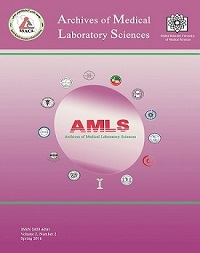The frequency of human leukocyte antigen-DRB1 alleles, using sequence-based genotyping in 68 parents-child trios study in Iranian subjects
Archives of Medical Laboratory Sciences,
Vol. 2 No. 2 (2016),
16 September 2016,
https://doi.org/10.22037/amls.v2i2.14526
Background: The human leukocyte antigen-DRB1 (HLA-DRB1) locus is one of the most polymorphic human loci and has a crucial role in the immune system. Assessing the allelic frequencies of HLA-DRB1 locus would be a fundamental factor in defining the origin of populations, relationships with other populations, disease association studies and the constitution of unrelated bone marrow donor registries. In the current study HLA-DRB1 alleles and their frequencies are determined in a family-based study by DNA sequencing-based typing high-resolution (2 field) level of typing.
Materials and Methods: Genomic DNA from 3 members of 68 unrelated families (a total of 204 individuals) was extracted. Exon 2 of DRB1 gene was amplified and performed useing AssignTM SBT v4.7 sequence analysis software.
Results: We had DRB1*11:04 with frequency of 0.0931, DRB1*03:01 with 0.0882, DRB1*11:01 with 0.0735, DRB1*13:01 with 0.071 and also alleles DRB1*08:03, DRB1*13:42, DRB1*14:04 and DRB1*14:07 with frequency of 0.0024.
Conclusion: A total of 34 different alleles were found in the study subjects with DRB1*11:04, DRB1*03:01, DRB1*11:01 being the most frequent alleles respectively.
